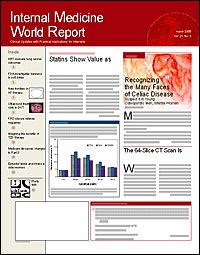Publication
Article
Internal Medicine World Report
AAN Outlines Role of Carotid Endarterectomy in Stroke Prevention
Author(s):
From the American Academy of Neurology
Carotid endarterectomy (CE) is effective treatment for symptomatic patients with 70% to 99% internal carotid artery (ICA) stenosis but should not be considered in symptomatic patients with <50% stenosis, according to an evidence-based report produced by a team of vascular neurologists appointed by the American Academy of Neurology (AAN) (Neurology. 2005;65:794-801).
The analysis is based on data from the North American Symptomatic Carotid Endarterectomy Trial (NASCET) and the European Carotid Surgery Trial (ECST). Both studies enrolled patients who had a carotid distribution transient ischemic attack (TIA) or nondisabling stroke within the previous 6 months and who were assigned to best medical therapy, either alone or with CE.
In NASCET, patients with 70% to 90% stenosis significantly benefited from CE. The absolute risk reduction for ipsilateral stroke at 5 years was 16% and 4.6% in patients with 70% to 99% and 50% to 69% stenosis, respectively. CE did not benefit patients with 30% to 49% angiographic stenosis, and it was harmful in patients with <30% stenosis.
Both trials yielded similar results when ECST angiograms were analyzed according to NASCET criteria.
To determine if CE provides benefits in asymptomatic patients, the team assessed data from 3 large studies. One study enrolled 1662 patients with 60% to 99% angiographically defined stenosis, the second study enrolled 444 men with 50% to 99% asymptomatic stenosis, and the third study included 3120 patients with >=60% stenosis who had no symptoms within the past 6 months.
The AAN investigators concluded that it is reasonable to consider CE in asymptomatic patients aged 40 to 75 years with 60% to 99% stenosis who have a life expectancy of >=5 years and in whom the risk of surgical stroke or death can be reliably documented to be <3%.
In NASCET and one other study, CE failed to provide clear benefits in symptomatic women with 50% to 69% stenosis. A subgroup analysis from NASCET revealed that patients with hemispheric TIA/stroke benefited more from CE than patients with retinal ischemic events.
The greatest benefits of CE were found to be in men, patients >75 years old, and patients who had their last symptomatic event within the previous 2 weeks.
Radiologic factors that influenced the risk/benefit ratio of CE included status of the contralateral carotid artery and the angiographic appearance of the ICA. Contralateral occlusion negated the small benefit of CE in asymptomatic patients and was associated with increased operative risk but persistent benefit in symptomatic patients. In symptomatic patients with angiographic near-occlusion, CE was associated with a trend toward benefit at 2 years but with no clear long-term benefit.
"For patients with severe stenosis and a recent TIA or nondisabling stroke, CE should be performed without delay, preferably within 2 weeks of the patient's last symptomatic event," the investigators wrote.





